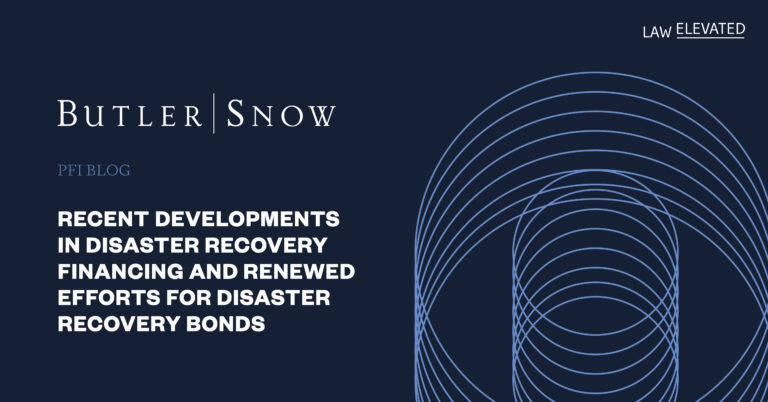Sadly, the past few weeks have seen extensive damage and disruption wrought by Hurricanes Francine, Helene, and Milton across the southeastern United States. One of the biggest hurdles a community faces after a disaster is the immediate need for capital to begin repairs and recovery efforts while awaiting FEMA reimbursements, which can often take years to fully materialize.
Over the past several years, Louisiana has repeatedly faced these challenges for immediate access to capital, and local governments (and certain nonprofits) have found a creative solution to bridge this funding gap: the use of tax-exempt bonds that are secured by the lawfully available funds or legally available revenues of a Louisiana local government entity under La. Rev. Stat. § 33:4548.6 or La. Rev. Stat. § 39:1430 respectively. In these bond issuances, payment of principal or interest was not directly or indirectly guaranteed by the federal government or any agency or instrumentality of the federal government, as barred by Section 149(b) of the Internal Revenue Code. Rather, the bonds were secured by a pledge of the governmental entity’s revenues and, should FEMA reimbursements never materialize, the governmental entity was obligated to make debt service payments from such revenues.
That said, the bonds were often structured so that the first debt service payment would coincide with the expected timetable for when FEMA reimbursements might begin, and the redemption provisions allowed for early redemption upon receipt of such FEMA reimbursements. In our experience working with FEMA cost recovery consultants, most reimbursements were expected to be received within three years and cover 90% of project costs. This structure allowed communities to address urgent needs without depleting their reserves and provides flexibility for managing the remaining 10% of project costs over the bond term (often around a ten-year term). The costs financed by such bonds were also carefully selected in consultation with the localities’ FEMA cost recovery consultants with an eye toward financing projects that should fit the criteria for FEMA reimbursement. Additional diligence was conducted by the purchasers of these bonds concerning project costs and anticipated reimbursement.
A significant development in 2023 was FEMA’s updated policy allowing reimbursement for reasonable costs of issuance and interest costs associated with disaster financing. According to the current practices of FEMA, the FEMA Guidebook and 2 CFR 200.449, these costs are reimbursable, making these financing tools even more effective by reducing borrowing costs for communities recovering from disasters.
State laws vary and borrowers should consult with bond counsel to determine which financing vehicles could be used to accomplish this end. By way of example, in North Carolina, use of N.C. Gen. Stat. § 160A-20 as a similar financing vehicle would be limited to a pledge of funds appropriated for repayment and require a security interest be provided in at least a portion of property financed by the local government. Additionally, borrowers should consult with bond counsel to determine what costs are allowable for financing under state and federal law. Typical costs have included hurricane debris removal and repairs to public facilities, but we are also aware of scenarios where local government expenses (such as utilities and salaries) were financed when there was no means of tax collections for several months post-storm.
Another type of disaster recovery financing may also take shape over the coming months to respond to the storms. Whether it will lead to a new and permanent category of tax-exempt debt, or a disaster-specific category created by special legislation remains to be seen.
Historically, Congress has passed bipartisan legislation to create special tax-exempt bond categories, providing reliable assistance to aid disaster-affected areas. Examples include Liberty Bonds after September 11, 2001; Gulf Opportunity Zone Bonds and Hurricane Ike Disaster Area Bonds following Hurricane Katrina and Hurricane Ike in 2005 and 2008; and Midwestern Disaster Area Bonds after severe storms and flooding in much of the Midwest. Each program was an impactful tool that helped the respective communities recover, but each also required a special act of Congress and months passed before capital became available. Given the scope of devastation from Hurricanes Francine, Helene, and Milton, similar legislation may be enacted in response.
Despite efforts to create permanent categories of disaster recovery bonds (see this NABL paper from 2018 that my colleagues John England and Caitlyn Burchfield contributed to), no permanent category of disaster recovery bonds has yet been created. The Council of Development Finance Agencies has renewed that call over the past few days.
